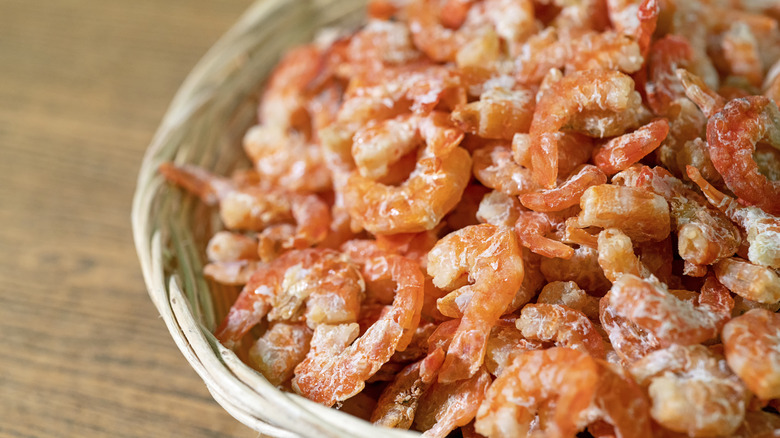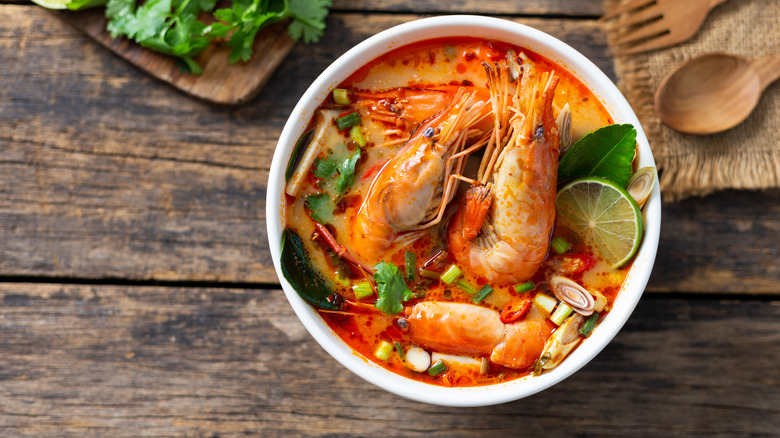The Umami Bomb Pantry Staple Marcus Samuelsson Uses Constantly
From dishes like dumplings filled with bone marrow to wild mushroom risotto drizzled with truffle oil, Chef Marcus Samuelsson knows how to bring rich umami flavor to the table. One of his top picks for imparting that flavor is shrimp powder. "I see shrimp powder being the next big thing. This ingredient really elevates certain dishes and gives great umami flavor," Samuelsson told Town & Country. The chef also sings the praises of the ingredient in a short on YouTube, telling viewers about the depth of flavor shrimp powder can add to savory dishes. He suggests using it in everything from soups and broths to rice and couscous.
There are a number of familiar foods that are packed with umami flavor that come from the sea, including fish sauce and anchovies. Shrimp powder may be less familiar to some home cooks who have never worked with the ingredient — what exactly is it and how is it made?
What shrimp powder is made of and how it's made
Shrimp powder is exactly what it sounds like — a fine, dry powder consisting of dried shrimp. Producers of the powder first dry the shrimp, sometimes in the sun. Then, the dried shrimp are grounded up to create the final product.
You can purchase shrimp powder at a store or online, but you can also make your own at home. First, you'll need to start with dried shrimp. You can purchase them or dry fresh shrimp in a dehydrator. Then, rinse the dried shrimp and allow them to air dry on a baking sheet. Be sure to allow the shrimp to dry completely — which may take several hours — to avoid introducing any water into the powder. Water can contribute to the formation of bacteria.
Once the shrimp are dry, use a blender or food processor to grind the shrimp until a fine powder forms. Then, transfer the powder to an airtight container. Freezing will help keep the shrimp powder fresh, and it can be added to recipes directly from the freezer.
Ways you can use shrimp powder
Once you've purchased or made shrimp powder, get ready to up the umami in your savory concoctions in the kitchen. Marcus Samuelsson uses it in a variety of recipes.
In his book, "The Rise: Black Cooks and the Soul of American Food: A Cookbook," he shares a recipe for making shito (a Ghanaian spicy chili sauce) and incorporates the powder into Double Dragon Rice with Grilled Shrimp in his Red Rooster Cookbook. He's also used it in a recipe for Food & Wine for Fonio Stuffed Collards with Pepper Sambal and Sauce Moyo, and he seasoned a simple Corn, Shrimp, and Scallop Ceviche on an episode of The Taste.
If you're looking to incorporate it into your meals, you can start simply by adding it to any soup or sauce that will benefit from its pleasantly salty flavoring. These include seafood-based soups, fried rice, stews, stir-fries, and even dips. One caveat is to season in moderation to avoid creating too much of a salty flavor.
In addition to using shrimp powder on its own, you can create your own seasoning blends. McCormick & Company recommends combining shrimp powder with crushed nori, white and black sesame seeds, brown sugar, ginger, and salt to make the Japanese seasoning Furikake. You can also get creative and craft your own signature blends.



